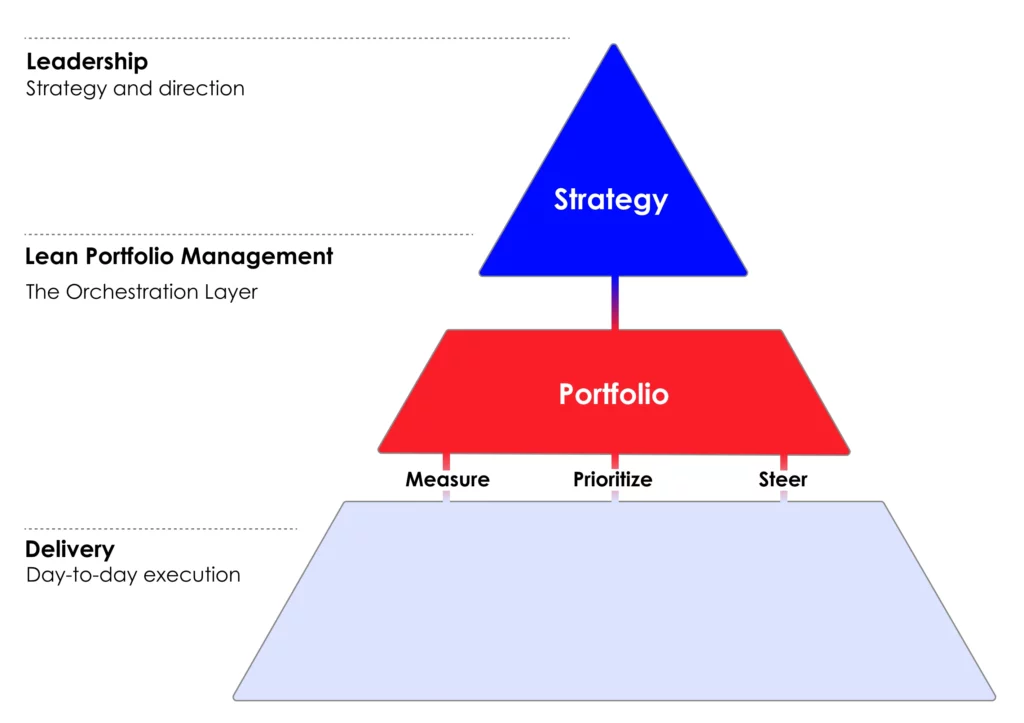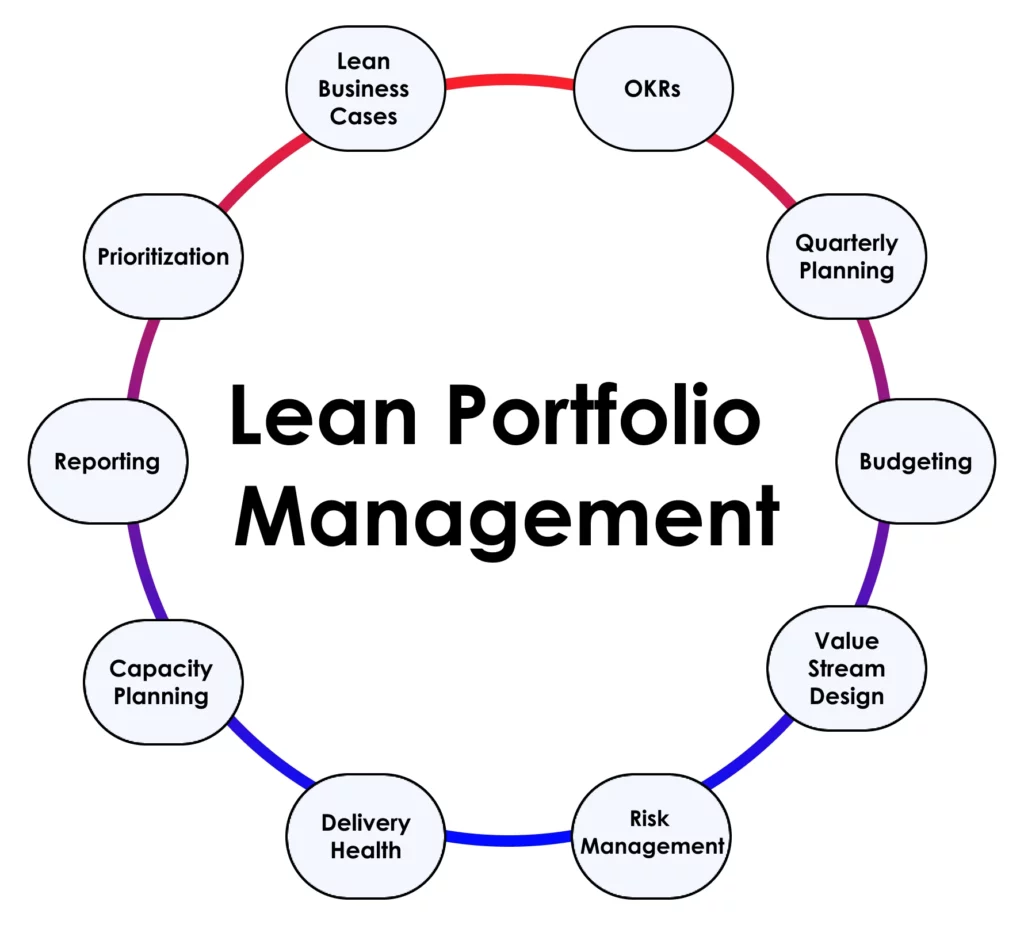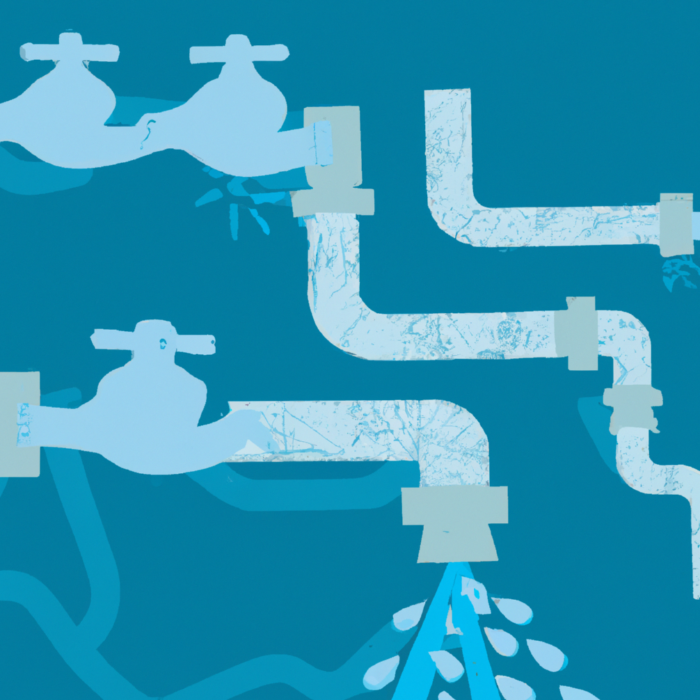Portfolio Planning
Practical introduction to Lean Portfolio Management (SAFe LPM)
In enterprise portfolio management, mastering the nuances of a wide range of new concepts like SAFe (Scaled Agile Framework for Enterprise), LPM (Lean Portfolio Management), ART (Agile Release Train), and PI (Program Increment) is essential. In an industry filled with acronyms that represent specific techniques and processes, precise communication is crucial, from the boardroom to the teams making it happen on the ground.
Organizations often have a clear vision of their portfolio strategy but may be uncertain about which specific framework, tools, or approach will best facilitate this outcome. This is where understanding the distinctions and applications of Lean Portfolio Management (LPM) within the context of SAFe becomes vital.
In this article, we will explore what Lean Portfolio Management (LPM) is and its role within the SAFe framework. We will explain the core principles, benefits, and practical implementation strategies of SAFe LPM, providing you with a comprehensive guide to optimize your portfolio management and drive value-centric outcomes.
What is SAFe Lean Portfolio Management (SAFe LPM)?
SAFe Lean Portfolio Management (SAFe LPM) is a specific implementation of Lean Portfolio Management within the Scaled Agile Framework (SAFe). It combines Lean principles with SAFe's structured practices and guidelines, providing a comprehensive approach to managing large-scale Agile transformations. SAFe LPM aims to align strategy and execution by integrating Lean principles at the portfolio level, ensuring that investments are optimized for maximum value delivery.
SAFe LPM is particularly effective in large enterprises and organizations with complex structures, such as finance, healthcare, government, and large technology companies. It is well-suited for organizations undergoing Agile transformations and those requiring robust governance and alignment mechanisms.

Benefits of Implementing SAFe LPM
Strategic Alignment
- Ensures Organizational Focus: By aligning portfolio investments with the organization’s strategic goals and objectives, SAFe LPM helps ensure that all initiatives contribute to the overall mission and vision. This alignment facilitates a unified direction and prioritization of work that drives the organization forward.
- Clear Prioritization: SAFe LPM provides a structured mechanism to prioritize initiatives based on strategic importance, ensuring that resources are allocated to the most critical projects. This strategic prioritization helps in achieving long-term business objectives more effectively.
Improved Governance
- Structured Governance Model: SAFe LPM establishes a clear governance framework with well-defined roles and responsibilities, such as the Lean Portfolio Management Office (LPMO). This structured approach ensures that decision-making is transparent and accountable, reducing the risk of misalignment and inefficiencies.
- Compliance and Accountability: The governance model within SAFe LPM ensures that all portfolio activities comply with regulatory requirements and internal policies. This structured oversight helps maintain accountability and adherence to best practices.
Enhanced Collaboration
- Cross-Team Coordination: SAFe LPM facilitates collaboration across different teams and departments by promoting a unified approach to value delivery. This cross-functional collaboration ensures that all parts of the organization work together towards common goals.
- Integrated Communication: By establishing regular communication channels and alignment events, such as PI (Program Increment) Planning, SAFe LPM enhances the flow of information across the organization. This integration ensures that teams are aware of dependencies, progress, and potential issues.
Scalable Framework
- Supports Large-Scale Transformations: SAFe LPM is designed to manage complex and extensive organizational structures, making it ideal for large enterprises undergoing Agile transformations. The framework can scale to accommodate multiple teams and portfolios, ensuring consistent practices across the organization.
- Adaptable to Growth: As organizations grow and evolve, SAFe LPM provides the flexibility to scale the framework to meet increasing demands and complexities. This scalability ensures that the portfolio management approach remains effective as the organization expands.
Predictable Delivery
- Cadence and Synchronization: SAFe LPM incorporates SAFe's cadence and synchronization mechanisms, such as PI Planning and Agile Release Trains (ARTs). These mechanisms ensure that teams work in a coordinated manner, aligning their efforts to deliver value predictably and reliably.
- Enhanced Visibility and Transparency: The use of visual tools like Kanban boards and regular reviews provides clear visibility into the progress of initiatives. This transparency helps stakeholders track the status of projects and make informed decisions to ensure timely delivery.
- Risk Mitigation: By adopting a structured approach to planning and execution, SAFe LPM helps identify and mitigate risks early in the process. This proactive risk management contributes to more predictable and successful outcomes.
Implementation and Scalability of SAFe LPM
One of the most powerful aspects of SAFe Lean Portfolio Management (LPM) is its ability to be implemented iteratively over time – it is in fact, recommended to implement in this way. The LPM framework provides a clear path for organizations to follow – it should not be thought of as an on/off switch.
Kiplot is explicitly designed to support this journey, allowing organizations to support and maintain their traditional portfolio while simultaneously driving best practices.
Implementation can be thought of as comprising of 10 key capabilities. Bringing each of these capabilities to life as an “MVP” and iterating their maturity over time is a powerful way to approach about your LPM implementation.

- OKRs
- Crystalizing your organization’s strategy into clear objectives and key results (OKRs) requires a mindset shift from project-led thinking to focusing on top-level organizational goals. Start with what you would like to achieve rather than what you would like to do.
- Explore our articles on OKRs to find out more or explore Kiplot’s OKR capability.
- Quarterly Planning
- Quarterly planning shifts the focus from annual cycles to more frequent, adaptable planning sessions. This approach allows teams to respond quickly to changes, align on priorities, and allocate resources effectively.
- Quarterly planning is sometimes known as PI Planning, though the PI Planning methodology has some more detailed connotations. This is similarly true of QBRs (quarterly business reviews). Though these concepts aren’t entirely synonymous with each other, they are similar and closely related.
- Discover how quarterly planning can enhance agility and ensure alignment with strategic goals in our detailed guides and articles.
- Budgeting & Financial Control
- Lean Portfolio Management offers the chance to eliminate lengthy investment cycles while maintaining rigorous financial controls through “capacity-led funding.” This assigns budget based on capacity, allowing for flexible adjustment to accelerate delivery.
- Learn more about demand management, investment, and budgeting in our dedicated whitepaper.
- Explore Kiplot’s budgeting capability.
- Value Stream Design
- Value stream design focuses on optimizing the flow of value from concept to delivery, ensuring that each step adds value and reduces waste. This involves identifying key processes and aligning them with business objectives.
- Our comprehensive guides on value stream mapping can help you streamline your initiatives and enhance efficiency.
- Risk Management
- Effective risk management involves identifying potential obstacles early and developing mitigation strategies to ensure continuity and resilience. Lean Portfolio Management integrates risk assessment with continuous planning to dynamically address risks.
- Discover our resources on proactive risk management strategies and tools for better governance.
- Delivery Health
- Monitoring delivery health is vital to maintaining the efficiency and effectiveness of your teams. It involves tracking key performance indicators (KPIs) and making data-driven decisions to improve processes.
- Our tools provide insights into delivery performance, helping you to maintain high standards and address issues promptly.
- Capacity Planning
- LPM puts capacity at the heart of delivery, recognizing it as a critical constraint. Kiplot helps organizations seamlessly and iteratively prioritize as conditions evolve, ensuring maximum utilization and productivity.
- To learn more about how capacity management and prioritization works in Kiplot, visit our resources.
- Reporting
- Maintaining real-time oversight of delivery is crucial. Kiplot integrates with tools like Jira and Microsoft Azure DevOps to provide data-driven analytics, enabling proactive management and ensuring priority outcomes remain on track.
- Kiplot’s delivery health algorithms offer leading indicators and warnings, allowing management to take timely action.
- Prioritization
- Effective prioritization ensures that the most valuable and strategically aligned initiatives are delivered first. This process requires balancing short-term demands with long-term goals, leveraging data and stakeholder input.
- Kiplot’s methodologies and tools support dynamic prioritization to adapt to changing business needs and optimize resource allocation.
- Lean Business Cases
- Lean business cases focus on delivering value efficiently by clearly outlining the benefits, costs, and risks of an initiative. They provide a framework for making informed investment decisions with agility.
- Explore our templates and best practices for creating compelling lean business cases that drive successful outcomes.
Conclusion
In this article, we've provided a high level introduction to Lean Portfolio Management within the wider Scaled Agile Framework for Enterprise framework, providing insights into its basic principles, and practices.
For those interested in exploring Lean Portfolio Management further and understanding how to implement these practices in their organization, Kiplot offers a wealth of features that enable organizations to effectively implement SAFe LPM within their organization – to enable accelerated agility whilst balancing efficiency and reducing waste. To learn more about Lean Portfolio Management and how Kiplot can help, explore our Lean Portfolio Management software.
Got a specific question? Keen to learn more about how you can use Lean Portfolio Management to transform your organization? Check out more of our articles below.






